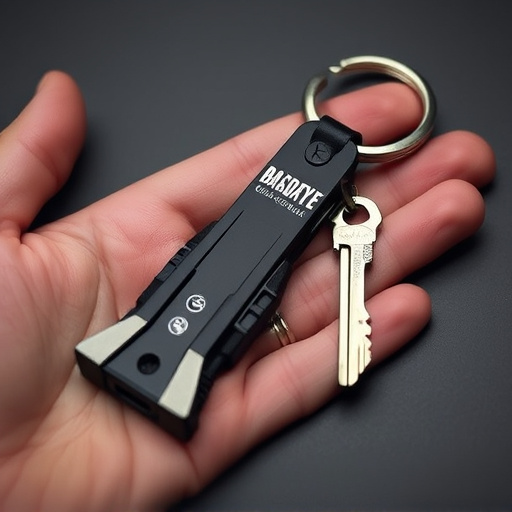Understanding local Legal Self Defense Keychain Regulations is vital before purchasing and carrying such a tool. Legality varies widely, with some areas having strict weapon restrictions including non-lethal self-defense tools. Keychains designed for personal safety must meet specific criteria like soft grip or limited disassembly to be compliant. Researching local laws, consulting official sources, and choosing non-lethal options like pepper spray ensure legal compliance while providing protection. The ideal keychain offers an ergonomic design with a secure grip and simple activation mechanism for swift deployment in high-stress situations.
In today’s world, self-defense tools that are both compact and effective are gaining popularity. One such device is the tactical keyring, designed for quick access and extreme situations. However, understanding legalities surrounding legal self-defense keychain regulations is crucial before equipping yourself. This article explores the intricacies of tactical grip design, its safety benefits, and key considerations for an effective self-defense keychain. We’ll also guide you through navigating market options to help choose the best tactical self-defense keyring, ensuring your peace of mind while adhering to legalities.
- Understanding Self-Defense Keychain Legalities: Unraveling Regulations
- Tactical Grip Design: Enhancing Safety and Efficacy
- Key Considerations for Effective Self-Defense Keychains
- Navigating Market Options: Choosing the Right Tactical Self-Defense Keyring
Understanding Self-Defense Keychain Legalities: Unraveling Regulations
When considering a tactical grip design self-defense keychain, it’s paramount to unravel the legalities surrounding these tools to ensure their possession and use align with local regulations. The legality of self-defense keychains varies greatly depending on your location, with some areas having strict restrictions on carrying any form of weapon, including small, non-lethal ones designed for personal safety. In many jurisdictions, self-defense keychains are only legal if they possess certain features that limit their potential as weapons, such as a soft grip or a design that doesn’t allow for easy disassembly.
Understanding these Legal Self Defense Keychain Regulations is crucial to avoid legal repercussions and ensure your peace of mind. It’s important to research the specific laws in your area and consult official sources to confirm what constitutes an acceptable self-defense tool. This due diligence can protect you from unintended consequences, especially if you travel to different regions with varying weapon possession laws.
Tactical Grip Design: Enhancing Safety and Efficacy
Tactical Grip design plays a pivotal role in enhancing the safety and efficacy of legal self-defense keychains, especially when navigating regulations surrounding their use. The focus on ergonomic and robust grip mechanisms ensures users can maintain control during critical moments, increasing the chances of de-escalation and effective defense. This is particularly important given varying legal Self Defense Keychain Regulations across different jurisdictions. Well-designed tactical grips incorporate features like non-slip materials, textured surfaces, and customizable fits to cater to diverse user needs and preferences, thereby optimizing performance in various scenarios.
Moreover, these designs consider not only the physical attributes of the grip but also the psychological aspect of confidence. A secure, comfortable hold instills a sense of assurance, allowing individuals to act swiftly and decisively when facing potentially dangerous situations. This psychological edge, coupled with physical capability, contributes significantly to personal safety in public spaces, adhering to legal frameworks while empowering users to take proactive measures for self-defense.
Key Considerations for Effective Self-Defense Keychains
When considering a self-defense keychain, it’s crucial to balance functionality with legal considerations. Different regions have varying regulations regarding what constitutes a legal self-defense weapon, so it’s essential to research and understand your local laws. Keychain defensive tools designed for legitimate self-protection must be non-lethal, meaning they should incapacitate an assailant without causing permanent harm. This often translates to tools like pepper spray or tactical flashlights rather than knives or firearms, which are typically more restricted.
Moreover, the design of your keychain should prioritize ease of use and reliability in a high-stress situation. A secure grip and simple activation mechanism can make all the difference when seconds count. Look for keychains with ergonomic designs that fit comfortably in your hand, ensuring you can deploy them swiftly and accurately when needed.
Navigating Market Options: Choosing the Right Tactical Self-Defense Keyring
Navigating the market for a tactical self-defense keyring involves careful consideration, especially with varying legal regulations surrounding self-defense tools. It’s crucial to understand that what works as a defense in one jurisdiction might be restricted or illegal in another. Therefore, buyers must stay informed about local laws and regulations regarding Legal Self Defense Keychain before making a purchase. This includes understanding the definition of a weapon, range restrictions, and any permit requirements.
Choosing the right tactical keyring means balancing functionality with legal compliance. Features like a sharp edge, tactical grip design, and quick-deploy mechanisms can enhance defense capabilities, but these must be selected with an eye towards their legality in your region. Staying within the boundaries of the law ensures that you’re prepared for emergencies without inviting legal consequences.
When it comes to self-defense keyrings, understanding both their tactical utility and legal limitations is paramount. By navigating the intricacies of regulations regarding legal self-defense keychain usage, and selecting a product with an innovative tactical grip design, individuals can empower themselves with a reliable tool for safety and protection. Remember, the right choice could make all the difference in a critical situation.
